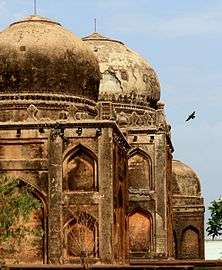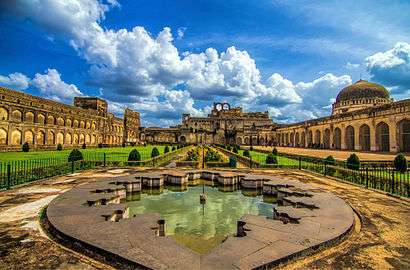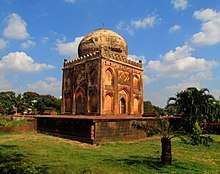Bidar Sultanate
Bidar sultanate was one of the Deccan sultanates of late medieval southern India.[2]
Bidar Sultanate Barid Shahi dynasty | |||||||||
|---|---|---|---|---|---|---|---|---|---|
| 1489–1619 | |||||||||
 Extent of Bidar Sultanate | |||||||||
| Capital | Bidar | ||||||||
| Common languages | Persian (official)[1] Deccani Urdu, Kannada | ||||||||
| Religion | Islam | ||||||||
| Government | Monarchy | ||||||||
| Barid Shah | |||||||||
| History | |||||||||
• Established | 1489 | ||||||||
• Disestablished | 1619 | ||||||||
| Currency | Mohur | ||||||||
| |||||||||
| Today part of | India | ||||||||
History
Qasim Barid and Amir Barid
The sultanate was founded in 1492 by Qasim Barid,[3] who was Georgian enslaved by Turks.[4] He joined the service of the Bahmani sultān Muhammad Shah III. He started his career as a sar-naubat but later became the mir-jumla (prime minister) of the Bahmani sultanate. During the reign of Mahmud Shah Bahmani (r.1482 – 1518), he became the de facto ruler.
After his death in 1504, his son Amir Barid became the prime minister and controlled the administration of the Bahmani sultanate. After the death of Mahmud Shah Bahmani in 1518, he was succeeded by four sultans, one after another, but they were mere puppets in the hands of Amir Barid.[5][6]
When the last Bahmani ruler Kalimullah fled to Bidar in 1527, Amir Barid became practically independent. But he never assumed any royal title.[7]
Ali Barid Shah
In 1542, he was succeeded by his son Ali Barid Shah I, who was the first to assume the royal title of Shah.[8] Ali Barid joined the other Deccan sultans in the battle of Talikota against the Vijaynagar Empire in January, 1565.
Later rulers
After his death in 1580, Ali Barid was succeeded by his son Ibrahim Barid, who ruled for seven years until his death in 1587.[9] He was succeeded by his younger brother Qasim Barid II.[10] After his death in 1591, he was succeeded by his infant son Ali Barid II, who was soon dethroned by one of his relative, Amir Barid II. In 1601, he was also overthrown by one of his relative, Mirza Ali Barid.
In 1609, he was succeeded by the last ruler, Amir Barid III,[10] who fought against the Mughals in 1616 under the leadership of Malik Ambar. In 1619, he was defeated by the Bijapur sultan Ibrahim Adil Shah II. Bidar was annexed to Bijapur sultanate. Amir Barid III and his sons were brought to Bijapur and kept "under surveillance"[11]
Culture
The rulers patronized Persianate culture. Persian poetry is inscribed on their tombs.
Architecture
The Bidar Sultanate made considerable additions to the Bidar Fort. Their tombs are also located at Bidar.[12][13] The rulers employed Hindu architects and engineers for the construction of these buildings, which resulted in amalgamation of some Hindu features within the architecture of this period.[14]
Rulers
| Name | Reign |
|---|---|
| Qasim Barid I | 1489 – 1504 |
| Amir Barid I | 1504 – 1542[15] |
| Ali Barid Shah I | 1542 – 1580[16] |
| Ibrahim Barid Shah | 1580 – 1587 |
| Qasim Barid Shah II | 1587 – 1591 |
| Ali Barid Shah II | 1591 |
| Amir Barid Shah II | 1591 – 1601 |
| Mirza Ali Barid Shah III | 1601 – 1609 |
| Amir Barid Shah III | 1609 – 1619 |
Gallery
- Bidar Fort near the entrance.
 Calligraphy in coloured tiles
Calligraphy in coloured tiles Ashtur Tombs
Ashtur Tombs.jpg)

 Tombs of Bidar Shahi kings at Barid Shahi Park in Bidar
Tombs of Bidar Shahi kings at Barid Shahi Park in Bidar Tombs of Bidar Shahi kings at Barid Shahi Park in Bidar
Tombs of Bidar Shahi kings at Barid Shahi Park in Bidar Tombs at Barid Shahi Park in Bidar
Tombs at Barid Shahi Park in Bidar
See also
- List of Shi'a Muslims dynasties
- List of Turkic dynasties and countries
- Battle of Talikota
References
Citations
- Spooner & Hanaway 2012, p. 317.
- "Barīd Shāhī dynasty | Muslim dynasty". Encyclopedia Britannica. Retrieved 9 December 2018.
- Sen 2013, p. 118.
- Bosworth 1996, p. 324.
- "India - Bahmanī consolidation of the Deccan". Encyclopedia Britannica. Retrieved 9 December 2018.
- Haig 1928, pp. 431.
- Yazdani, 1947, pp. 25.
- Yazdani, 1947, pp. 13.
- Yazdani, 1947, pp. 160.
- Yazdani, 1947, pp. 14.
- Majumdar 2007, p. 466-468.
- Law, John. Modern Hyderabad (Deccan). pp. 15–17.
- Centre, UNESCO World Heritage. "Monuments and Forts of the Deccan Sultanate". UNESCO World Heritage Centre. Archived from the original on 28 February 2018. Retrieved 9 December 2018.
- Yazdani, 1947, pp. 26.
- Haig 1928, pp. 429.
- Haig 1928, pp. 681 & 683.
Bibliography
- Bosworth, C.E. (1996). The New Islamic Dynasties. Columbia University Press.CS1 maint: ref=harv (link)
- Majumdar, R.C. (2007). The Mughul Empire. Bharatiya Vidya Bhavan.CS1 maint: ref=harv (link)
- Sen, Sailendra (2013). A Textbook of Medieval Indian History. Primus Books.CS1 maint: ref=harv (link)
- Spooner, Brian; Hanaway, William L. (2012). Literacy in the Persianate World: Writing and the Social Order. University of Pennsylvania Press.CS1 maint: ref=harv (link)
- Yazdani, Ghulam (1947). Bidar, Its History and Monuments. Oxford University Press.
- Haig, Sir Wolseley (1928). The Cambridge History of India Volume III. Cambridge University Press.
External links
- Philon, Helen (2019). "Barīd Shāhīs". In Fleet, Kate; Krämer, Gudrun; Matringe, Denis; Nawas, John; Rowson, Everett (eds.). Encyclopaedia of Islam, THREE. Brill Online. ISSN 1873-9830.